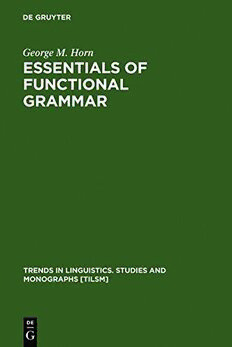Table Of ContentEssentials of Functional Grammar
Trends in Linguistics
Studies and Monographs 38
Editor
Werner Winter
Mouton de Gruyter
Berlin · New York · Amsterdam
Essentials of
Functional Grammar
A Structure-Neutral Theory of
Movement, Control, and Anaphora
by
George M. Horn
Mouton de Gruyter
Berlin · New York · Amsterdam 1988
Mouton de Gruyter (formerly Mouton, The Hague)
is a Division of Walter de Gruyter & Co., Berlin.
Library of Congress Cataloging-in-Publication Data
Horn, George M.
Essentials of functional grammar.
(Trends in linguistics. Studies and monographs ; 38)
Bibliography: p.
Includes index.
1. Grammar, Comparative and general. 2. Anaphora
(Linguistics) I. Title. II. Series.
P151.H57 1988 415 88-18947
ISBN 0-8992-5348-2 (alk. paper)
Deutsche Bibliothek Cataloging-in-Publication Data
Horn, George M.:
Essentials of functional grammar : a structure-neutral theory of
movement, control, and anaphora / by George M. Horn. -
Berlin ; New York ; Amsterdam : Mouton de Gruyter, 1988
(Trends in linguistics : Studies and monographs ; 38)
ISBN 3-11-011286-8
NE: Trends in linguistics / Studies and monographs
Printed on acid free paper.
© Copyright 1988 by Walter de Gruyter & Co., Berlin. All rights reserved, including
those of translation into foreign languages. No part of this book may be reproduced
in any form - by photoprint, microfilm, or any other means - nor transmitted, nor
translated into a machine language without written permission from Mouton de
Gruyter, a Division of Walter de Gruyter & Co., Berlin.
Printing: Ratzlow-Druck, Berlin - Binding: Lüderitz & Bauer, Berlin. - Printed in
Germany.
Acknowledgments
I am grateful to the following people for their
time and patience in assisting me with the data: Ola
Horn (Polish), Anita van der Wal (Dutch), Melinda
Meredith (Samoan), Nobuaki Nishioka (Japanese),
and Kiyoharu Ono (Japanese). I, of course, take full
responsibility for the accuracy of the data and the
conclusions reached.
I also wish to thank Geraldine MacNeill and
Peter Peterson for their help in editing and proof-
reading. Special thanks are due to Joyce Bennett,
who worked long hours typing the manuscript and
assisting in the editing and revision. Her services
have been invaluable.
INTRODUCTION
Lexical-Functional Grammar, Horn (1983a), is essentially a collection
of analyses of various bodies of data which are formulated in a
functional framework related to that of Bresnan et al., yet differing
from it in certain significant respects. This basic approach, I believe, is
correct, but the emphasis is on the mechanical properties of the rules of
the model, and relatively little attention is given to higher-level
generalizations.
Here, I develop a coherent theory of universal grammar (UG) along
the same general lines. In this proposal, UG is composed of general rule
schemata and related principles and parameters which together define,
in effect, the notion "possible grammatical process." The major
grammatical processes which I consider are what are traditionally
labelled movement, control, and anaphora. Cross-language variation in
each of these areas is a consequence of variation of the values of the
relevant parameters.
On this level, the proposed theory can be more meaningfully
compared with the Government and Binding (GB)Theory and the other
variant of Lexical-Functional Theory in the context of the debate over
the configurational/non-configurational distinction and the nature of the
rules and principles which provide the best explanation of the behavior
of languages of these two types. The most important specific
innovations of this proposal are the following:
(a) The operations on F-structures discussed in Horn (1983a) are
shown to be subcases of two generalized rule systems: the Argument
Reduction System and the Generalized Co-Indexing System. The first
includes the passivization process, certain other lexical and non-lexical
processes which were discussed briefly, and object deletion. The
Argument Reduction rules are roughly analogous to, but more general
than, the Move NP subcase of the Move-α rule in the GB Theory. The
remaining operations, the co-indexing rule, the Raqui rule, the
reflexive/reciprocal rule, and the Gerundive/Infinitive Phrase Subject
Interpretation Rule, are subcases of a single General Co-Indexing Rule,
which is the analog of the control and anaphora rules of the GB theory,
but, which again, applies to a rather wider domain.
(b) An S-structure/F-structure Interface Component has been added
to UG. This contains rales and principles which mediate between the
S-structure and F-structure levels. The role of grammatical functions,
as well as the relationship between case and grammatical function is
more clearly developed, and the Grammatical Relations Deletion Rule,
whose sole function was a house-keeping one, is eliminated.
(c) The four universal F-structure types are replaced by a single
canonical form. This, along with a small set of parameters, provides
a definition of the notion "possible predicate."
(d) The constraints on the EA rule, which is the analog of wh-
movement in the GB Theory, are generalized. The Noun Phrase
Constraint (NPC) is shown to be a subcase of a more general Predicate
Argument Constraint, which defines the conditions under which both
NPs and APs are islands as well as those under which they are not. The
NPGOC is eliminated. A set of parameters associated with the remain-
ing two constraints defines the range of cross-language variation of the
patterns of wh-movement.
Some knowledge of the material in Horn (1983a) will be helpful, but
not essential to understanding this proposal.
TABLE OF CONTENTS
Introduction i
Chapter I: Preliminary Remarks 1
1. Universal Grammar 1
2. Configurational and Non-configurational Languages 4
3. Structural and Functional Theories of UG 9
4. Hie Proposed Theory 31
Chapter Π: Basic Concepts 35
1. Overview 35
2. Basic F-structure Components: Predicates 40
3. Basic F-structure Components: Arguments 60
4. Building Complex F-structures 87
5. The S-structure/F-structure Interface 99
6. Summary and Concluding Remarks 125
Notes 142
Chapter III: The Co-Indexing System: A Reanalysis of
Control and Bound Anaphora 165
1. Introduction 165
2. The Short-range Control Relation 167
3. Bound Anaphora 185
4. The Long-range Control Relation 199
5. Unification 215
6. The Generalized Co-Indexing System 222
Notes 229
Chapter IV: The Argument Reduction System:
A Reanalysis of Bounded Movement
and Deletion 243
1. Introduction 243

